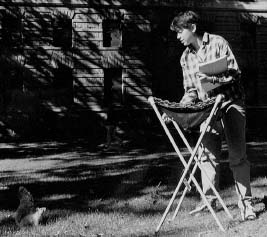Princeton Weekly Bulletin October 26, 1998
Which acorns are eaten and why?

 By
Caroline Moseley
By
Caroline Moseley
Surely you've seen them by now: They look like miniature BBQ grills, set up beneath many campus trees. These mysterious objects are seed traps, part of a research project organized by graduate student Leila Hadj-Chikh of Ecology and Evolutionary Biology.
She is studying "the relationship between oak regeneration and the foraging behavior of gray squirrels," she says. The squirrels under examination are the familiar campus critters, (both gray and black belong to the same species, Sciurus carolinensis, according to Hadj-Chikh). And the participating trees are red oaks, which produce both large and small acorns: "The Northern red oak produces large acorns, about 4 to 7 grams, and the pin oaks produce smaller ones, about 2 to 3 grams."
Folk wisdom dictates that "great oaks from little acorns grow"but only if the acorn gets safely buried in the earth so that it can germinate. And acorns get buried "by squirrels caching them for future meals," Hadj-Chikh points out.
Squirrels, of course, cache acorns for their own dining pleasure, not to aid in oak regeneration. And oaks drop acorns to make more oak trees, not to feed squirrels. But between them, both oaks and squirrels flourish.
Which acorns are forgotten
"The reproductive strategies of plants may influence or be influenced by the cache-recovery behavior of seed hoarders," Hadj-Chikh observes.
"If patterns of cache recovery are correlated with genetically-based seed characteristics, such as size, then cache recovery may represent an important stage of seed selection."
Among the questions Hadj-Chikh will explore are which acorns get forgotten (and left to germinate), which are eaten by the squirrel who buried them, and which are eaten by other squirrels. She is also interested in knowing if squirrels preferentially bury or eat small acorns or large ones.
The current phase of her research is "designed to examine differences in cache recovery patterns," Hadj-Chikh says. She plans to give acorns to 20 marked squirrels; she will then remove half those squirrels and take them to the Stony Ford Center for Ecological Studies"EEB's field station about five miles from town."
There, she will compare the rate of recovery for acorns that were cached by the squirrels still on campus with the recovery rate for caches of the squirrels moved to Stony Ford. "This will give me an indication of how much these caches are being pilfered by other squirrels."
The experiment will also yield information as to "whether one type of acorn is more likely to be stolen than another." Hadj-Chikh wants "to see if acorn size is related to the probability of eventual recovery."
She will "be able to monitor the removal of caches because all the acorns will have small magnets glued to them." A steel tag will identify the Northern red oaks, and a brass tag will identify the pin oaks, and a metal detector will tell her "whether the signal is from steel or brass, so I can tell which species of acorn it is."
How much food is available
And why the seed traps?
"I have the seed traps set out because I want to know what other factors might affect the rate of pilfering," Hadj-Chikh explains. For example, "Seeds might be more likely to be stolen in places where there's a lot of food and lots of squirrels foraging about."
Hence, she is counting the number of seeds on the ground to figure out how much food is available on different parts of campus. "But I need to know how many seeds are actually falling from the trees in order to tell how many are being removed by squirrels. I can't measure removal rates unless I know the input, and the seed traps show me the input."
The approximately 35 seed traps were constructed by Hadj-Chikh herself, of black plastic weed block and PVC tubing purchased from Home Depot. "They cost about $3 each to build," she says.
Most now have plastic netting over the top to let acorns in and keep curious people out, as campus bipeds have proved more of a problem than quadrupeds. Many of the traps have been knocked over or removed, Hadj-Chikh reports. Others have been used as receptacles for cigarette butts, gum wrappers and beverage cans. An unidentified party added 100 acorns to a trap. "And last week someone tossed in a quarter."
Though she says, "I do accept donations," Hadj-Chikh makes a heartfelt plea for community noninterference with her seed traps.
"The campus isn't a playground," she declares, "It's an institution of learning. If data are tampered with, they become invalid. I could, without realizing it, publish something that wasn't the truth. I can't imagine anything worse happening to a scientist."